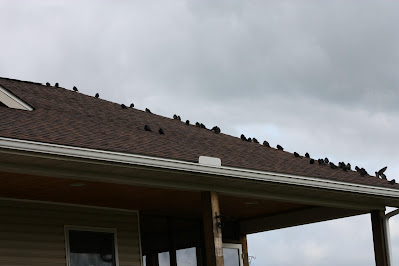This year's purple martin season just flew by. I wasn't able to spend as much time with them as I usually did in previous years, but it was enough to do nest checks and make sure there were no major issues. I wasn't able to do nest checks for the last 4 weeks due to some other unforeseen issues, but, my numbers this year at last count were: 82 pair, roughly 310 fledged (without confirmation of the last 8 nests). They all finally left my site during the second week of July.
Yes, I still had my resident GHO show up...she's kinda like Dory in the movie, "Finding Nemo"...she just keeps swimmin' hoping she'll find & catch a martin one night.
I'm sure, in the end, she probably caught a few that exited for the magical "Dawn Song" hours, but at least it wasn't a slaughter. The cages continue to work well, especially with the netting underneath. I had a very determined Sharp-Shinned hawk at the beginning of the season, prior to my mounting of the netting. He/She actually came up inside the cages a couple of times to try to catch a martin. But after mounting the netting on the racks, he/she never attempted that again.
 |
| Great Horned Owl - May 6, 2024 - 9:00 PM |
 |
| Great Horned Owl, stalking my colony from the nearby perching rack. May 7, 2024 - 4:38 AM |
I had been meaning to construct a new bird bath and an elderly gentleman that came by to pick up some stuff ended up pushing that decision up in my priority list when he accidentally backed over my old bird bath arrangement. I had been itching to re-do it anyway, given the bird bath arrangements my friends were sharing on social media. So, very frankly, after he destroyed my original setup, I may have secretly cheered. Ha!
Given the various issues I had with my old bird bath (and lessons-learned), I had a better plan this time.
I wanted:
- a 'waterfall' bath with an upper & lower tray;
- more water capacity in the trays themselves;
- a large capacity water container (so I didn't have to keep refilling the trays during extreme heat) ;
- a pump to circulate the water; and
- a better location for birdie access and out of the way of people who should no longer be driving a vehicle.
I found the perfect trays on Amazon (thanks to a friend's help) and hubby and I decided to make a trip to our local hardware store to try to find ideas on how to make the water supply system more self-sustaining. After quite some time walking around, a store associate helped us find a nifty item called a "bulkhead flange". OMG, this thing is awesome! It has a gasket on one side to help seal the hole and a lock nut on the other side so you can tighten it. We drilled the right size hole in the bottom of the tray, mounted it, then used a small length of PVC pipe to set the level of the water for the lower tray. I placed some screen over the hole and used a zip tie to hold it in place. It filters a lot of stuff out before it can get into the water-holding bin.
 |
| Male & female bluebirds |
 |
| Male cardinal |
 |
| Female Cowbird - contemplating her life decisions. |
 |
| Female Orchard Oriole |
 |
| The look on the field sparrow's face (in the lower tray), when a pair of Grey Catbirds fly in to take a bath (hehe). |
 |
| Field Sparrow - he/she has earned frequent bather awards. |
 |
| Dickcissel contemplating a bath |
 |
| Cardinal and a Bluebird |
 |
| Blue-winged warbler (yellow bird) and Indigo Bunting |
 |
| Female Indigo Bunting |





















.JPG)
















